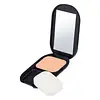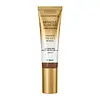What's inside
What's inside
 Key Ingredients
Key Ingredients

 Benefits
Benefits

 Concerns
Concerns

 Ingredients Side-by-side
Ingredients Side-by-side

Mica
Cosmetic ColorantTalc
AbrasiveDimethicone
EmollientEthylhexyl Methoxycinnamate
UV AbsorberSilica
AbrasiveTrimethylsiloxysilicate
EmollientNylon-12
Methicone
EmollientCholesteryl Stearate
EmollientTocopherol
AntioxidantBHT
AntioxidantDiethylhexyl Succinate
EmollientEthylhexyl Hydroxystearate
EmollientHydrogen Dimethicone
Methylparaben
PreservativePropylparaben
PreservativeSodium Dehydroacetate
PreservativeCI 77891
Cosmetic ColorantCI 77492
Cosmetic ColorantCI 77491
Cosmetic ColorantCI 77499
Cosmetic ColorantMica, Talc, Dimethicone, Ethylhexyl Methoxycinnamate, Silica, Trimethylsiloxysilicate, Nylon-12, Methicone, Cholesteryl Stearate, Tocopherol, BHT, Diethylhexyl Succinate, Ethylhexyl Hydroxystearate, Hydrogen Dimethicone, Methylparaben, Propylparaben, Sodium Dehydroacetate, CI 77891, CI 77492, CI 77491, CI 77499
Water
Skin ConditioningCyclopentasiloxane
EmollientPhenyl Trimethicone
Skin ConditioningGlycerin
HumectantMica
Cosmetic ColorantCetyl PEG/PPG-10/1 Dimethicone
EmulsifyingDiisopropyl Dimer Dilinoleate
EmollientCocos Nucifera Oil
MaskingTrimethylsiloxysilicate
EmollientZinc Oxide
Cosmetic ColorantSodium Chloride
MaskingPEG-10 Dimethicone
Skin ConditioningAmmonium Acrylates Copolymer
Phenoxyethanol
PreservativeDisteardimonium Hectorite
StabilisingAlpha-Glucan Oligosaccharide
CleansingLecithin
EmollientPentylene Glycol
Skin ConditioningChlorphenesin
AntimicrobialPropylene Carbonate
SolventParfum
MaskingTocopheryl Acetate
AntioxidantIsopropyl Titanium Triisostearate
EmollientAlcohol Denat.
AntimicrobialPolymnia Sonchifolia Root Juice
Skin ConditioningAloe Barbadensis Leaf Juice
Skin ConditioningAscorbyl Glucoside
AntioxidantCitric Acid
BufferingFructose
HumectantSodium Hydroxide
BufferingUrea
BufferingDisodium Deceth-6 Sulfosuccinate
CleansingMaltodextrin
AbsorbentRetinyl Palmitate
Skin ConditioningTriethoxycaprylylsilane
Cocos Nucifera Fruit Extract
EmollientLaureth-30
CleansingPEG-60 Hydrogenated Castor Oil
EmulsifyingHexyl Cinnamal
PerfumingAllantoin
Skin ConditioningMaltose
MaskingSodium Lactate
BufferingSodium PCA
HumectantTrehalose
HumectantBenzyl Benzoate
AntimicrobialCitronellol
PerfumingLinalool
PerfumingSodium Dehydroacetate
PreservativeLactobacillus
Skin ConditioningPanthenol
Skin ConditioningTocopherol
AntioxidantCaprylyl Glycol
EmollientGlucose
HumectantSodium Hyaluronate
HumectantPhenethyl Alcohol
MaskingEugenol
PerfumingPotassium Sorbate
PreservativeSodium Benzoate
MaskingGeraniol
PerfumingSilybum Marianum Seed Extract
Skin ConditioningHelianthus Annuus Seed Oil
EmollientRosmarinus Officinalis Leaf Extract
AntimicrobialPentaerythrityl Tetra-Di-T-Butyl Hydroxyhydrocinnamate
AntioxidantPantolactone
HumectantBHT
AntioxidantLimonene
PerfumingIron Oxides
CI 77891
Cosmetic ColorantWater, Cyclopentasiloxane, Phenyl Trimethicone, Glycerin, Mica, Cetyl PEG/PPG-10/1 Dimethicone, Diisopropyl Dimer Dilinoleate, Cocos Nucifera Oil, Trimethylsiloxysilicate, Zinc Oxide, Sodium Chloride, PEG-10 Dimethicone, Ammonium Acrylates Copolymer, Phenoxyethanol, Disteardimonium Hectorite, Alpha-Glucan Oligosaccharide, Lecithin, Pentylene Glycol, Chlorphenesin, Propylene Carbonate, Parfum, Tocopheryl Acetate, Isopropyl Titanium Triisostearate, Alcohol Denat., Polymnia Sonchifolia Root Juice, Aloe Barbadensis Leaf Juice, Ascorbyl Glucoside, Citric Acid, Fructose, Sodium Hydroxide, Urea, Disodium Deceth-6 Sulfosuccinate, Maltodextrin, Retinyl Palmitate, Triethoxycaprylylsilane, Cocos Nucifera Fruit Extract, Laureth-30, PEG-60 Hydrogenated Castor Oil, Hexyl Cinnamal, Allantoin, Maltose, Sodium Lactate, Sodium PCA, Trehalose, Benzyl Benzoate, Citronellol, Linalool, Sodium Dehydroacetate, Lactobacillus, Panthenol, Tocopherol, Caprylyl Glycol, Glucose, Sodium Hyaluronate, Phenethyl Alcohol, Eugenol, Potassium Sorbate, Sodium Benzoate, Geraniol, Silybum Marianum Seed Extract, Helianthus Annuus Seed Oil, Rosmarinus Officinalis Leaf Extract, Pentaerythrityl Tetra-Di-T-Butyl Hydroxyhydrocinnamate, Pantolactone, BHT, Limonene, Iron Oxides, CI 77891
Ingredients Explained
These ingredients are found in both products.
Ingredients higher up in an ingredient list are typically present in a larger amount.
BHT is a synthetic antioxidant and preservative.
As an antioxidant, it helps your body fight off free-radicals. Free-radicals are molecules that may damage your skin cells.
As a preservative, it is used to stabilize products and prevent them from degrading. Specifically, BHT prevents degradation from oxidation.
The concerns related to BHT come from oral studies; this ingredient is currently allowed for use by both the FDA and EU.
However, it was recently restricted for use in the UK as of April 2024.
Learn more about BHTCi 77891 is a white pigment from Titanium dioxide. It is naturally found in minerals such as rutile and ilmenite.
It's main function is to add a white color to cosmetics. It can also be mixed with other colors to create different shades.
Ci 77891 is commonly found in sunscreens due to its ability to block UV rays.
Learn more about CI 77891Mica is a naturally occurring mineral used to add shimmer and color in cosmetics. It can also help improve the texture of a product or give it an opaque, white/silver color.
Serecite is the name for very fine but ragged grains of mica.
This ingredient is often coated with metal oxides like titanium dioxide. Trace amounts of heavy metals may be found in mica, but these metals are not harmful in our personal products.
Mica has been used since prehistoric times throughout the world. Ancient Egyptian, Indian, Greek, Roman, Aztec, and Chinese civilizations have used mica.
Learn more about MicaThis ingredient is a preservative with antimicrobial properties. It is the sodium salt of dehydroacetic acid.
It is especially effective at preventing bacterial and fungal growth in low concentrations.
Tocopherol (also known as Vitamin E) is a common antioxidant used to help protect the skin from free-radicals and strengthen the skin barrier. It's also fat soluble - this means our skin is great at absorbing it.
Vitamin E also helps keep your natural skin lipids healthy. Your lipid skin barrier naturally consists of lipids, ceramides, and fatty acids. Vitamin E offers extra protection for your skin’s lipid barrier, keeping your skin healthy and nourished.
Another benefit is a bit of UV protection. Vitamin E helps reduce the damage caused by UVB rays. (It should not replace your sunscreen). Combining it with Vitamin C can decrease sunburned cells and hyperpigmentation after UV exposure.
You might have noticed Vitamin E + C often paired together. This is because it is great at stabilizing Vitamin C. Using the two together helps increase the effectiveness of both ingredients.
There are often claims that Vitamin E can reduce/prevent scarring, but these claims haven't been confirmed by scientific research.
Learn more about TocopherolThis silicone is an emollient. Emollients create a thin film on the skin to prevent moisture from escaping.
It is not soluble in water and helps increase water-resistance in products.
According to a manufacturer, it can blend seamlessly with silicone oils, such as Cyclopentasiloxane.
Learn more about Trimethylsiloxysilicate